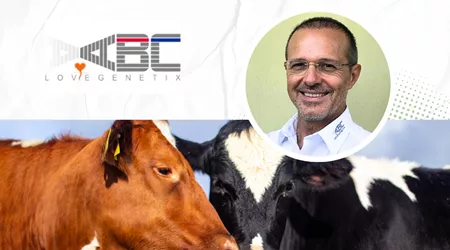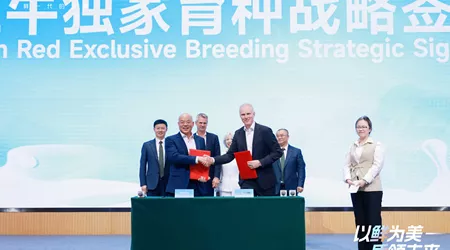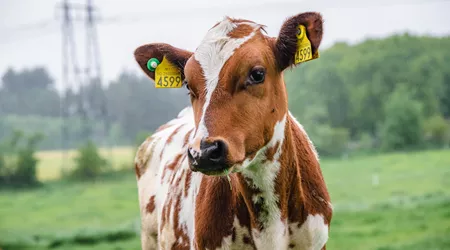In a Trade Talk interview, Bruce Ronalds, ABS Australia's Business Operations Manager, discusses seasonal challenges, the rising interest in Norwegian Red genetics, and key factors influencing Australian dairy farming. He provides insights into the growing demand for Norwegian Red genetics, shifts in crossbreeding practices, and essential traits shaping the future of Australian dairy cattle.
Q: Please tell us about yourself and your work
A: My name is Bruce Ronalds and I have been working for ABS in Australia for more than 23 years. I grew up on a dairy farm in Gippsland, Victoria, and studied for my Bachelor of Applied Science at the University of Melbourne while specializing in dairy cattle reproduction.
I started my job with ABS being involved with inventory management and customer service where I worked with dairy farmers to fill their orders for semen and merchandise. I currently work as the Australia Business operations manager which involves production planning and marketing of all breeds here in Australia while working with the industry to find the best bulls through genomic testing that will work in Australian conditions. The main dairy breeds we work with are Holstein, Jersey, and Norwegian Reds. Over the past 2 years, I have seen the potential growth in the NR breed and working with farmers and industry as Australia embraces red genomics.
Q: Can you share insights into the dairy industry in Australia?
A: Australia is a very seasonal farming system with two very distinct joining periods and a real focus over the last 10 years has been daughter fertility. Cows that present for breeding need to get in calves so that they return to milk with their herd mates. Australia has been focused on high production based on a grazing system but many more farms are feeding more supplements than ever before due to changes in climatic conditions and a decrease in family farms to cooperative bigger farms. Whilst farm numbers have declined, cow numbers in each herd have risen.
Today there has been more of a focus on health traits like somatic cell count, daughter fertility, calving ease, and cows that last in the herd. We have also seen many farms look towards a more sustainable future using homozygous polled and A2/A2 sires within their breeding programs along with more feed-efficient cows that produce.
Q: How is dairy crossbreeding perceived in Australia?
A: Crossbreeding has its place here in Australia amongst commercial herds. This is due to the benefits that can be optioned through hybrid vigor. These benefits include cow fertility, cow health, and creating cows that last longer in the herd. 10-15 years ago crossbreeding involved the crossing of breeds that were less conducive on type and left some breeders disappointed. Today however there is an increase in demand where farmers are now strategically using a three-way cross bringing in the Norwegian red as a second or third sire with some outstanding results for both production and no production traits.
Q: What are the main drivers for using Norwegian Red genetics in Australia?
A: Demand for Norwegian red continues to increase amongst both Aussie red and cross-breeding herds. Many farmers are impressed with the genetic gains that the NR brings to both the red breeder and those choosing to cross with the breed. Now with all the bulls tested on both the Norway index and the Australian index (Balanced Performance Index (BPI) this gives farmers the confidence to use these bulls
Many bulls rank very well for production whilst great attention to cows that are highly fertile and get back in calf quickly. Many of the Norweigen red sires lead the Australian red breed list for Daughter Fertility which has been a huge focus for farmers here. Also having cows that have a greater resistance to mastitis and lower somatic cell counts are a must and many are excited to hear that this has been an emphasis of the Geno programs for many years.
The other beauty of the program in Norway is the fact that many sires are polled which helps remove the need to dehorn. Many farmers that are using Homozygous polled sires are thrilled when the calves hit the ground and not even one of them needs dehorning. The helps when many of these bulls are not compromised in their genetics.
Q: Could you provide insights into the primary trends in dairy cattle genetics in Australia?
A: One of the biggest trends here in Australia is the increased use of Sexcel. Many are genomic testing their female replacements and then using Redx sexed semen on their higher genetic females to make the next generation. There is a real push to remove bobby calves from the market here and make sure all animals have a purpose in life. This has huge benefits as a breeder can increase their genetic gain in a shorter period of time.
Q: What type of dairy cow should Australian dairy farmers anticipate to meet future trends (in the next 5-10 years)?
A: I think there will be a little move away from type and a continued focus on Production and health traits. Farmers want a more efficient cow that will last in the herd. This will be one of the bigger focuses in the future as many farms are asked to produce protein more efficiently. This will be from both an environmental aspect and also with rising costs of imports farms will be looking to boost efficiency to be more profitable.
Q: Which traits are the most important to consider when you select Norwegian Red sires for your market?
A: Here in Australia, we are working very closely with Knut Ingolf Dragset who is the area manager for Geno. We are continuing to add more bulls to the reference population for genomics here in Australia. Finding the top BPI bulls is a priority and bulls that work under the Aust condition are a must. I am confident we will continue to find these bulls that will be elite for genomics for Australia and meet the needs of those in Australia



